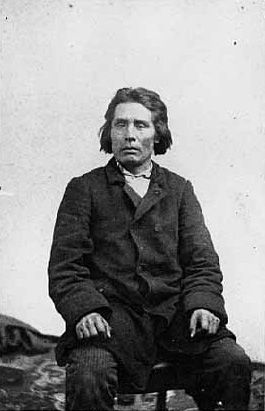 Taopi
Taopi was born in Kaposia, Little Crow's village. After the Treaty of Mendota in 1851, the village was removed to a reservation near the Lower Sioux Agency. There,
Taopi took
on farming, eventually becoming a leader of the Dakota farmers. In 1860, he joined with Good Thunder and Wabasha, a Mdewakanton chief, in starting a school and mission on the reservation called the Hazelwood Republic.
During the U.S.-Dakota War, Taopi was a member of the Peace Party and worked to protect captives. He was imprisoned after the war, but gained protection from Henry Sibley and testified against Dakota who had killed settlers. He was allowed to stay in Minnesota on Alexander Faribault's land.
"On the morning of the 18th of August, 1862 I was preparing to go down to the Mission House, the residence of our minister, the Rev. Mr. Hinman. He had promised to go with me to assist in laying out our burial lot near the new church. My child had been buried but a few days before. As I was about starting, the old man (Tah-e-m-na) came to my house and said, "All the upper bands are armed and coming down the road." I asked, "For what purpose are they coming?" He said, "I don't know." The old man had hardly gone out when Ta-te-campi came running to my house and said, "They are killing the traders." I said, "What do you mean?" He said, "The Rice Creek Indians [Shakopee's band] have murdered the whites on the other side of the Minnesota River , and now they are killing the traders." I said. "This is awful work."
As soon as he was gone I heard the report of guns. I went up to the top of my house and from there I could hear the shouts of the Indians and see them plundering the stores. The men of my band now began to assemble at my house. We counseled, but we could do nothing to resist the hostile Indians because we were so few and they were between us and the settlements. I told them not only to keep out of the disturbance but also not to go near the plunderers. Some of them obeyed me. I sent Good Thunder with a message to Wabasha, but he could not reach his house on account of the hostile Indians. The hostile Indians soon came to our village and commanded us to take off our citizen's clothing and put on blanket and leggings. They said they would kill all of us "bad talkers." We took our guns and were prepared to defend ourselves. We did not know what to do. I wanted to take my wagon and go to the whites, but I could not.
Good Thunder came back and brought news that nearly a whole company of soldiers from the fort had been killed at the Ferry. Good Thunder and Wa-ha-can-ka-ma-za and myself went into my cornfield to talk over the matter. We wanted to escape the fort that night, but we could not because we were watched. We determined to go to the whites at the first opportunity. I proposed to take two white girls who had been taken prisoners at Redwood, and take them to within a short distance of the fort, and them send them in with a letter stating that we were ready to cooperate with the whites in any way they might direct. We were ready, but the girls were afraid to go."
-Taopi
 Taopi was born in Kaposia, Little Crow's village. After the Treaty of Mendota in 1851, the village was removed to a reservation near the Lower Sioux Agency. There, Taopi took on farming, eventually becoming a leader of the Dakota farmers. In 1860, he joined with Good Thunder and Wabasha, a Mdewakanton chief, in starting a school and mission on the reservation called the Hazelwood Republic.
Taopi was born in Kaposia, Little Crow's village. After the Treaty of Mendota in 1851, the village was removed to a reservation near the Lower Sioux Agency. There, Taopi took on farming, eventually becoming a leader of the Dakota farmers. In 1860, he joined with Good Thunder and Wabasha, a Mdewakanton chief, in starting a school and mission on the reservation called the Hazelwood Republic.



